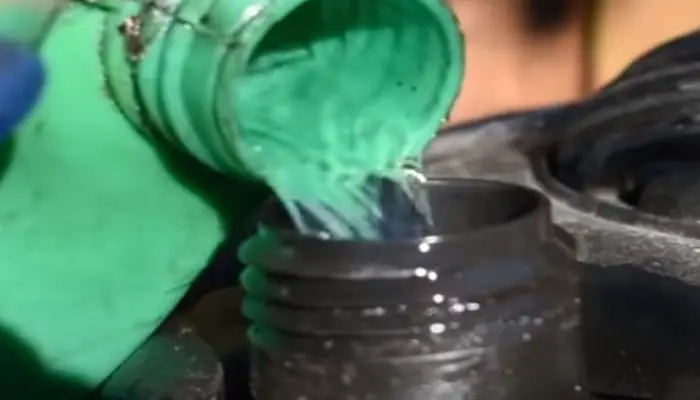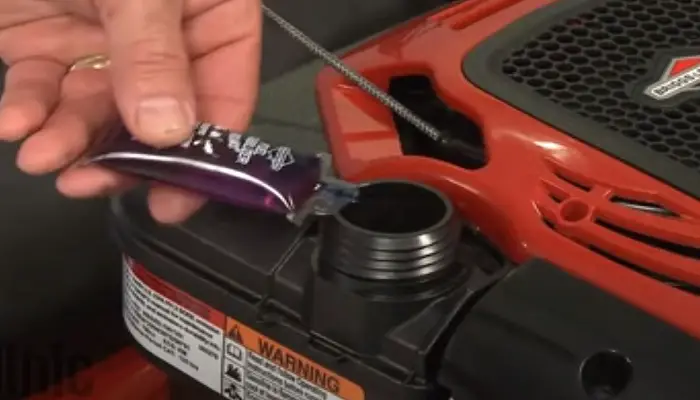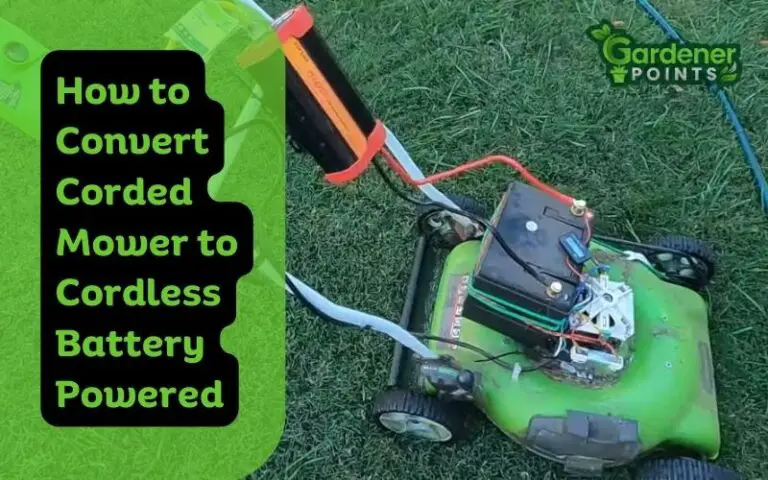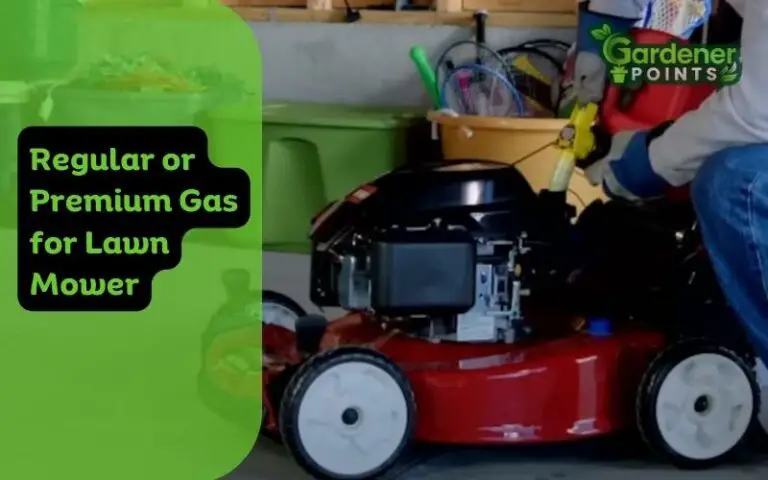Lawn Mower Hard to Start When Cold – How to Fix?
Lawn mowers tend to face troubles in early spring or early fall. The weather outside is considerably cold during this time which can make starting any mower challenging.
Lawn mowers are hard to start when cold issues may arise due to incorrect oil viscosity, faulty spark plugs and old gasoline. Additionally, clogged fuel lines, fuel filters and air filters along with dirty carburetors can also be the culprits for this issue.
So, if you’re having issues starting the lawn mower in cold weather, this guide will tell you everything you need to know!
Why Lawn Mower Hard to Start When Cold?(6 Reasons)
There is not just one thing causing issues in your lawn mower in a colder environment. A variety of reasons could be at fault for which lawn mower engine turns over but still refuses to start completely.
1. Reduced Oil Flow Due To Wrong Oil Viscosity

Engine oil is graded based on their viscosity and each lawn mower has their own specifications for the right oil viscosity. During cold weather, the oil viscosity increases as a side effect.
Therefore, the necessary oil flow required to start the engine inside the lawn mower isn’t provided. The oil becomes too thick and fails to lubricate the inner components.
In order to not face this issue, choose a grade of engine oil which successfully functions in cold weathers. For colder weathers, 5W-30 or 10W-30 viscosity oil works perfectly. Even so, you should check with the manual provided by the manufacturer to make sure you get the right kind of oil.
2. Defective Spark Plugs

One of the most common reasons for the lawn mower to be hard to start when it’s cold is a faulty spark plug.
Carbon deposits and corrosion in the spark plug can damage them to a great extent. Wrong electrode gaps in the spark plug might also create issues within it.
Moreover, the connection with the spark plug might be too loose or worn out. However, the damage is, the defect in these spark plugs fail to ignite the combustion process in the engine. As a result, the lawn mower is hard to start no matter what.
At the front of the lawn mower, locate the spark plug and remove it to inspect what’s wrong with it. Use a thin wire brush to remove any kind of carbon buildup or dirt in the plug.
You can also try fixing the electrode gaps and see if it works. If the plug is way too damaged for repair, consider getting a new one instead.
3. Incorrect Setting Of Choke

Choke is one of the main necessities for a lawn mower to start in the cold. The choke regulates how much air should be flowing into the carburetor.
This pushes a larger amount of fuel to create the combustion for the engine. The choke level can be set to a wrong position to cause troubles unknowingly.
The choke might not open and close properly if the linkage is stuck. If the choke is not working or the choke lever is not in the full position, the airflow inside the carburetor will be too much for it.
As a result, the lawn mower won’t start when it’s cold without the choke. You can remove the casing for the air filter to get to the choke and choke lever.
Make sure the choke cable is lubricated enough and adjusted properly. Move around the lever to ensure it opens and closes properly. Set the choke to the full position and keep it on.
4. Dirty Carburetor

The function of a carburetor is to mix a proper amount of gas and fuel during the engine combustion process. However, after not using the lawn mower during the winter, it becomes unused for a while.
The ethanol mixed in the fuel starts creating foamy substances and spreading over the carburetor. This clogs up the carburetor line and corrodes the carburetor components too much.
You can use a carburetor cleaner with compressed air to clean out these dirty, coated substances from the carburetor. Another option is to get an ultrasonic cleaner for just $100 to easily clean the carburetor.
If just cleaning the carburetor doesn’t work and it’s out of order instead, replace it in the repair shop.
5. Clogged Fuel Line or Filter

Since the fuel filter prevents any dirt from getting inside the fuel tank, it can very well be coated with dust itself.
The accumulated dirt builds up in the fuel filter over time and blocks the filter. A blocked filter won’t allow any fuel to pass through in order to start the engine.
Similarly, the fuel lines can also get blocked by debris and dirt at any time. Additionally, if the gas in your tank is too old, it will produce a sticky substance as a result of the oxidation of the old gas.
This sticky substance disrupts the air-fuel flow by clogging up the fuel line, so the mower is hard to start.
Do a full checkup of the fuel line and filter to ensure they’re not clogged. To clean the fuel line periodically, spray cleaner into the fuel line first.
Then, blow compressed air to get rid of the accumulated debris and dirt. You can clean the fuel filter the same way. If the residue refuses to go away at all, replace the fuel line or filter as necessary.
6. Too Old Gas In The Tank

One of the main rules of maintaining a lawn mower is that you can’t let the gas sit in your tank for too long.
The reason for this is the natural oxidation and evaporation of the gas over time. If the gas sits in the tank for more than 30 days, it begins to break down and oxidize.
Nowadays, most gas contains substances like ethanol. This component, upon oxidizing, creates a varnish-like sticky substance. When you try to start the lawn mower, this substance gets into the tank and causes issues with the engine.
So don’t let the fuel sit in your tank for 30 days. Empty out the tank with a fuel siphon. Thoroughly clean the fuel tank to rid it of any residues.
Afterwards, add fresh gas to the tank. It is recommended to use fuel additives in order to reduce moisture. If you tend not to use the mower for a long time in the winter, use a fuel stabilizer to avoid this problem.
How to Cold Start a Lawn Mower? (5 Steps To Follow)
Even though it might be a little hard, starting the lawn mower in the cold is not entirely impossible. It will only take a few minutes to prepare all the components ready to start. But keep in mind it is not the permanent solution.
Follow these quick steps in order to cold start a lawn mower (These Steps are Explained After The Video):
- Remove the spark plug from the front of the mower.
- Use a brush wire to clean off the remaining debris and carbon deposits in the spark plug.
- Spray starter fluid at the front of the plug and reattach it.
- Disconnect the air filter and clean it similarly before attaching it again.
- Press the primer button of the mower three times. You’ll find this button close to the air filter.
- Wait until the button is back to normal, and then press it three times again.
- Now, starting the engine will work successfully, and the mower will achieve a cold start.
Step 1: Clean the spark plug

At first, you must clean the spark plug of the lawnmower. It is important since the spark plug will accumulate debris and oil residues when not used for a long time. It would help if you disconnected its cap first. Then, unscrew the entire spark plug from the lawnmower engine.
Now look for oil residues and carbon build-up on the spark plug. When identifying the residues, use a wire brush to remove the debris from the plug. Finally, spray starting fluid on the entire spark plug. Now you can remount the plug and connect the cap properly.
Step 2: Clean or replace the air filter
When the lawnmower isn’t used for a long time, the air filter will also accumulate debris. The air filter supplies air to the engine and carburetor to help them work appropriately. So, when there’s debris on the air filter, it fails to supply the required amount of air to the engine.
Thus, take out the air filter from the lawnmower engine. Now, inspect it thoroughly to know how much dirt it has gathered. If the air filter isn’t too dirty and you can clean it, use the wire brush to remove the dirt and debris from it.
However, if the air filter is dirtier than expected, you should replace it. Air filters are cheap and easily gettable in hardware stores. Also, you may purchase it from the lawnmower store. Once you get the new air filter, mount it in its actual position.
Step 3: Check the carburetor

Before you consider starting the lawnmower, you should also check the carburetor. Sometimes, oil spills or debris might clog the carburetor.
When the carburetor gets dirty, it will not mix the air and fuel according to the right ratio. Thus, the combustion engine of the lawnmower will not start.
Therefore, you should check the carburetor thoroughly. If you think it needs cleaning, wash it off using a neat and clean rag.
For this, apply the carburetor cleaner using a straw in the air intake of the component. You should always use premium carburetor cleaner to yield the best filtering results for the carburetor.
Step 4: Check and adjust the oil level
Finally, you must check the oil level of your lawnmower. Usually, every lawnmower has a recommended oil level mark.
You should maintain the oil level to help the engine deliver the best performance. If the fuel tank has old gas or fuel, drain it.
After that, refuel the tank with the new gas. Always use premium gas as fuel instead of regular gasses.
If you use regular gas for the lawnmower engine, initially, you may save a few cents. But, in the long run, it will cost you to replace the lawnmower.
Step 5: Start your lawnmower
When you have checked the air filter, carburetor, and spark plugs of the lawnmower, you can proceed to start it.
First, observe the air filter to find the primer button. Once you have found the primer button, press it three times without any delay.
After that, remove your thumb from the primer button. It allows the primer button to get back to its original position. Once the switch gets back to its actual position, press it three times continuously.
Finally, press the starting switch of the lawnmower. Once the engine starts, allow it to get warm-up for a few seconds. Now, you can start cutting the grass with the lawnmower.
Also, note that you might convert an electric lawnmower to a cordless one if you find it difficult to move the corded one. We have a separate guideline on it.
How to Warm Up a Lawn Mower?
Many homeowners complain that their lawnmower takes many pulls to start. It usually happens when the engine is idle for a few months and has become cold. Thus, you will need to warm up the lawnmower engine before starting it.
Nonetheless, you should understand that warming up the lawnmower refers to warming up the carburetor. You can’t warm up or heat the engine itself. So, how do you warm up the carburetor of your lawnmower?
The process is easier than most homeowners might expect. The steps include:
- Place a 60W light bulb close to the lawnmower carburetor. However, ensure that you don’t put it too close to the carburetor. Otherwise, the bulb’s heat might burn the carburetor wiring to damage the engine.
- Now, connect the bulb with the electric outlet using proper wiring. Turn on the outlet to help the bulb light up adequately.
- You should ensure that the bulb remains in its position without any movement. You need to keep the bulb lighted for 10 to 20 minutes.
This way, you may warm up the carburetor of the lawnmower. Nonetheless, many experts suggest that you don’t need to warm up the lawnmower at all. Don’t try to straighten the carburetor blade with heat as part of your warming up process. You should ensure that the light bulb is positioned securely so that it doesn’t burn any wiring and components inside the engine.
Frequently Asked Questions (FAQs)
Let’s take a look at some more information we’ve gathered during the hunt for lawn mower starting problems in the cold.
What Temperature Is Too Cold For Starting a Lawn Mower?
The perfect working range for a lawn mower is between 40°F and 90°F. So, if the temperature goes below 40°F, it is officially too cold to start a lawn mower. Most lawn mowers aren’t used during heavy winters due to this restriction.
What To Do After Turning On A Hard To Start Lawn Mower?
After fixing the root cause of the cold start issues, doing routine maintenance is mandatory for the mower. Get an oil change monthly, clean the filters, fuel lines and carburetor regularly. Get a checkup done once in a while at a local mower shop too.
Final Words
This guideline on how to cold start a lawnmower after a long time includes possible reasons for the engine not starting and their fixing steps.
If your lawnmower still fails to start, it might be due to internal damages. Thus, you need to call a mechanic to fix it, or you might even need to buy a new one.
So, maintain your lawnmower properly to avoid such inconveniences.

Say hello to Afrabby – your go-to research expert turned gardening expert, lawn care aficionado, and a skilled lawn mower mechanic! With years of hands-on experience and a passion for cultivating lush green landscapes, Afrabby is your partner in achieving the lawn of your dreams.
Whether you’re seeking expert advice on plant selection, weed control, or optimal mowing techniques, Afrabby’s got you covered. Equipped with the knowledge to diagnose and fix mower troubles, your lawn equipment is in safe hands. Let Afrabby transform your outdoor space into a stunning oasis you’ll love to show off!




![How to Know if Mower Blade Is Upside Down? [5 Easy Hacks]](https://gardenerpoints.com/wp-content/uploads/2023/08/Mower-Blade--768x480.jpg)
